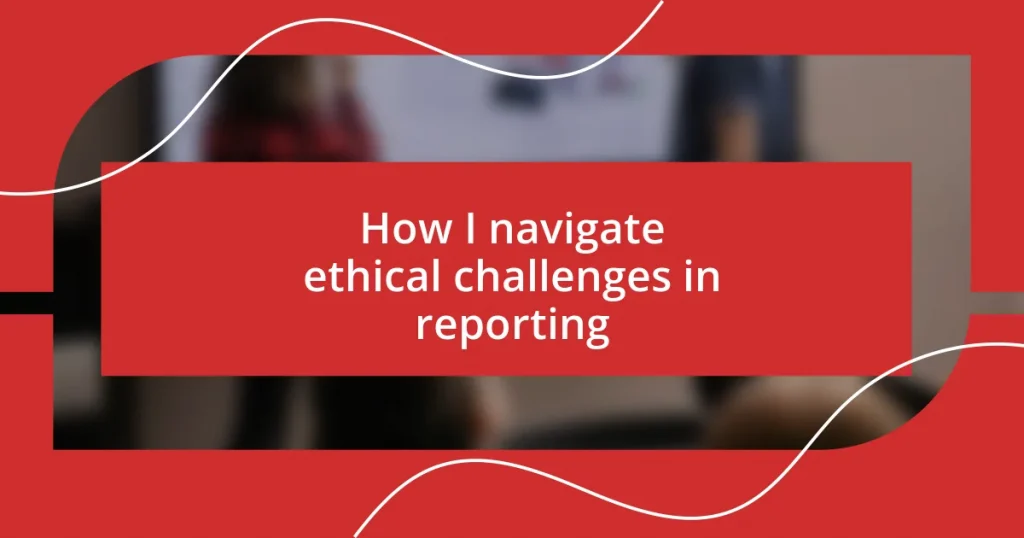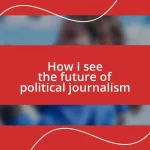Key takeaways:
- Ethical reporting requires balancing truth with the potential impact on individuals and communities, emphasizing the importance of sensitivity and responsibility.
- Identifying common ethical challenges involves navigating dilemmas such as public interest versus privacy, conflicts of interest, and the tension between sensationalism and responsible storytelling.
- Engaging diverse perspectives enriches narratives, fosters inclusivity, and enhances the depth of stories by reflecting underrepresented voices.

Understanding ethical reporting standards
Ethical reporting standards are crucial in guiding how I approach my work as a journalist. From my experience, it’s not just a set of rules; it feels like a moral compass that shapes my decisions every day. Reflecting on a story I once covered about a local community issue, I realized that presenting facts responsibly meant digging deeper to understand the implications of my words on those involved. How can I share a narrative without considering the impact it might have on someone’s life?
When I navigate these standards, I often weigh the truth against the potential harm it could cause. I recall a time when I had to choose whether to disclose sensitive information about a public figure. In that moment, I asked myself, “What good is honesty if it destroys someone’s reputation without reason?” Such reflections drive me to find a balance between transparency and accountability, which, for me, is at the heart of ethical reporting.
Moreover, understanding ethical standards means acknowledging the diverse perspectives present in every story. I remember interviewing a family affected by a tragic event; it struck me how each member had a different experience and view of what happened. This taught me that ethical reporting isn’t just about conveying facts but also about humanizing the story and honoring the voices involved. Don’t we all deserve to have our stories told with sensitivity?

Identifying common ethical challenges
Identifying ethical challenges is often less straightforward than it seems. I’ve encountered situations where the line between public interest and privacy blurred, especially during an investigation into a local corruption case. One particular moment stands out: I received information that could expose a whistleblower, yet I had to weigh the community’s right to know against safeguarding someone’s safety. Balancing such decisions is pivotal to fair and ethical reporting.
Another challenge is dealing with conflicts of interest. Reflecting on one assignment, I was invited to cover a charity event for an organization connected to a close friend. I found myself questioning my ability to remain objective. Would my relationship compromise my reporting? I chose to disclose my connection, and that clarity not only preserved my integrity but also strengthened my reporting. Transparency, as I’ve learned, is a key ally in navigating such murky waters.
Sometimes, the most pressing ethical dilemmas arise from sensationalism versus responsible reporting. In one instance, while covering a tragic accident, I saw the temptation to create a headline that would draw attention but could exacerbate the family’s grief. Instead, I opted for a respectful tone that focused on the community’s response and support. This experience reinforces my belief that ethical journalism champions sensitivity over sensationalism.
| Common Ethical Challenges | Examples |
|---|---|
| Public Interest vs. Privacy | Balancing revealing information about individuals, such as whistleblowers, with their right to privacy. |
| Conflicts of Interest | Dealing with personal connections that may affect objectivity, like covering events linked to friends. |
| Sensationalism vs. Responsible Reporting | Choosing between attention-grabbing headlines and respectful narratives that honor the affected. |

Balancing truth and transparency
Finding the right balance between truth and transparency can be a delicate dance. I remember a time when I covered a sensitive political story about a local leader whose decisions had serious consequences on the community. Sharing the unvarnished truth was essential, but I felt that simply broadcasting negative details could jeopardize the progress the community was trying to make. It made me ponder whether being transparent was truly helpful or if it merely served to deepen divides.
In navigating these situations, I often rely on a mental checklist that helps steer my decisions:
- Assess Real Impact: How will sharing this information affect the individuals involved and the broader community?
- Context Matters: Is the truth being represented in a way that provides necessary background, rather than just sensationalism?
- Respect Boundaries: Are there personal or emotional boundaries that should be respected when reporting on sensitive topics?
- Clarity of Intent: Am I motivated by the public’s right to know or am I simply seeking attention for my story?
By asking myself these questions, I strive to ensure that my reporting is both truthful and considerate. After all, the goal is to inform, not alienate. Each story requires that unique touch, and often, my decisions hinge on more than just raw facts; they are also shaped by a fundamental respect for the people whose lives are impacted by my words.

Seeking diverse perspectives in reporting
Delving into diverse perspectives has been a game changer in my reporting journey. I vividly recall reporting on a community initiative aimed at supporting local immigrants. I realized that interviewing individuals from varying backgrounds brought to light not just the challenges faced but also the unique strengths these communities offered. This multifaceted approach enriched my narrative and painted a more holistic picture of the initiative’s impact. Isn’t it fascinating how one story can take on a life of its own when you let different voices be heard?
Often, I find myself pondering the significance of inclusivity in reporting. When I covered a mental health awareness campaign, I made it a point to speak with individuals who had lived experiences, as well as professionals in the field. Hearing their stories fostered a deeper understanding of the stigma surrounding mental health, offering insights that statistical data alone couldn’t provide. It’s moments like these that reinforce my belief in advocating for underrepresented voices; they remind me that every perspective adds depth and nuance to our shared experiences.
Maintaining a commitment to diversity means actively seeking out viewpoints that challenge the status quo. One memorable instance involved an environmental story where I spoke with an indigenous leader advocating for sustainable practices. Initially, I was hesitant to incorporate their perspective, fearing it might deviate from the mainstream narrative. However, their insights not only transformed the way I viewed the issue but also highlighted the importance of ancient wisdom in modern debates. Isn’t it empowering to realize how often the most valuable stories come from voices we might overlook? In this line of work, I’m reminded that expanding our lens leads to richer, more impactful storytelling.

Implementing guidelines for ethical decisions
Implementing clear guidelines for ethical decisions in reporting can serve as an essential roadmap on difficult paths. For me, developing a personal code of ethics was a gradual yet pivotal process. One evening, while wading through a complex investigation about corporate malfeasance, I realized I needed more than just intuition; I required a set of principles that reflected my commitment to responsible journalism. It was then I started crafting my own guidelines to help navigate those murky waters more confidently.
In practice, these guidelines often translate into specific actions during stories. I vividly recall grappling with a situation where a confidential source came forward with critical but potentially damaging information. Remembering my principles, I weighed my responsibility to the public against potential harm, and ultimately chose to corroborate the story with verifiable data. It was this kind of discernment that reassured me I was respectful of my ethical obligations while pursuing the truth. How can we ensure that each decision aligns with our core values? It’s a question worth considering, as it directly affects the integrity of our work.
On a broader scale, creating a collaborative environment for discussing ethical dilemmas has proven invaluable. I often engage with colleagues to unpack challenging cases, leveraging their insights to refine my decision-making process. Once, after presenting a controversial topic about social inequality, it was a peer’s perspective that opened my eyes to a bias I hadn’t considered before. It reminded me how collective wisdom can illuminate blind spots, guiding us toward ethical clarity. So, as you ponder your own ethical guidelines, ask yourself: who can you turn to for support in these crucial decisions?















